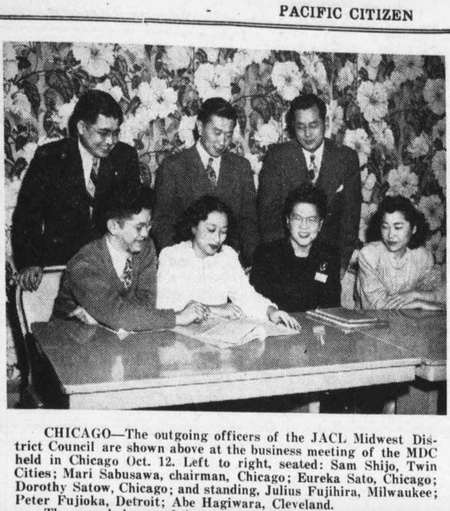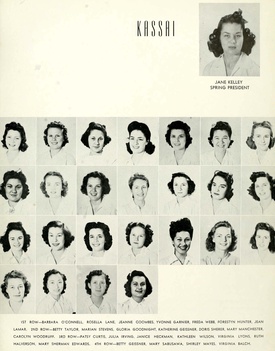One arena of public life in which Japanese Americans have achieved great visibility during the 20th century is the arts. A constellation of brilliant Nisei artists, including Isamu Noguchi, Ruth Asawa, George Nakashima, Shinkichi Tajiri, Frank Okada, and Satoru Abe, won renown on the national and international level for their work. Curiously, one of the most outstanding Nisei contributors to the American artistic and literary scene was Mari Sabusawa Michener, a woman who never produced any artwork or creative fiction on her own. Instead, she served as companion and supporter of her husband, the prolific novelist James A. Michener.
Both individually and together, the Micheners built up a vast collection of contemporary American art, and donated an estimated $100 million in money and artwork to museums, universities, and other institutions. Yet before her years as writer’s muse and philanthropist, Mari Sabusawa Michener built a career as an activist and civil rights advocate, a mission that strongly influenced her later development.
Mari Yoriko Sabusawa was born on June 17, 1920 in Las Animas, Colorado, the daughter of Sutakichi Sabusawa, a melon farmer and house cleaner who died in 1929. In 1936 Mary Sabusawa, as she as known then, moved with her family to Long Beach, California. It is unclear whether the Sabusawas were connected to the Sugihara family, who had moved from Las Animas to Long Beach some time earlier, but it would seem likely.
The Sugiharas operated a produce market in Long Beach, while Mary’s older brother Harry was listed in census reports as a produce market worker. Mary attended the same church and school as Ina Sugihara, a year her senior—a woman who would go on to make important contributions as a journalist and civil rights activist in New York City.
Mary Sabusawa attended high school at Long Beach Polytechnic and was part of its Japanese Friendship Circle. She also joined the Nipponettes, a local Nisei girls club. Meanwhile, she became active in Long Beach’s Japanese Presbyterian Church, serving as secretary and Chairman of the local branch of Christian Endeavor. She served as art director the Church’s Young People’s biweekly magazine, The Sea-Shell. She also played a part in a Christian play, “the Cross Triumphant”, that was performed there.
After graduating from high school in 1938, Mary Sabusawa attended Long Beach Junior College. During this period, she became active with the local Japanese American Citizens League, serving as an officer. Her fellow Nisei remarked on her intelligence and leadership skills. In September 1941, she won the Southern District JACL oratorical contest. The topic of her address was “What is Our Part in the Present Emergency?”
Sabusawa hoped to enroll at UC Berkeley, where Ina Sugihara had taken up studies. However, in Spring 1942, following Executive Order 9066, Sabusawa was sent with her family into confinement at Santa Anita, and then to the Amache camp in Colorado (Ironically, it was located only 50 miles from her hometown of Las Animas). Almost no sooner did Sabusawa arrive in camp, however, than she was permitted to leave. Through the efforts of John W. Thomas of the American Baptist Home Mission Society, she was offered a scholarship at Antioch College.
Sabusawa, who was the first-ever Japanese American student at Antioch, majored in political science and international relations there. Meanwhile, she distinguished herself on campus. She served as Chairman of Antioch’s College Race Relations Committee for two quarters, during which she assisted in efforts to raise scholarship funds to bring three outstanding Black students to attend the school. As a student representative on the Community Council, Sabusawa spent a great deal of her time delivering talks on Japanese Americans at outside venues. For example, in October 1944 she and her fellow student Nao Okuda spoke before the Co-operative Club in Xenia, Ohio on the social, economic and political problems faced by resettlers. She was elected Hall President of her dormitory.
Through Antioch’s cooperative job program, Sabusawa spent a term in Washington, D.C., where she analyzed Japanese news and propaganda for the Foreign Broadcast Intelligence Service. Then in 1944-45 she moved to Chicago, where she took up work with the American Council on Race Relations (ACRR), a newly-formed race relations clearing house and lobbying group. At ACRR Sabusawa worked with its director, Robert Weaver, a Harvard-trained economist who in 1965 would be appointed as the first African American Cabinet official.
In 1946, following the end of World War II, Mari Sabusawa (as she now called herself) enrolled in a graduate sociology program at the University of Chicago, specializing in race relations. Around the same time, she was hired as Assistant Director of ACRR—in the process becoming a full-time professional in race relations work.
During her tenure, the ACRR sponsored studies on housing and job discrimination against African Americans and other minorities, and provided information to the general public. For example, the ACRR engaged the Nisei sociologist Setsuko Matsunaga Nishi, Sabusawa’s fellow student at University of Chicago, to compile an antiracist pamphlet, “Facts About Japanese Americans.” In 1946, Sabusawa returned to Antioch to speak at a conference, “Techniques for Good Race Relations,” on behalf of ACRR.
In 1947, she served as the official hostess at a summer institute at the University of Chicago on “Race Relations and Community Organization” that was jointly sponsored by the University and the ACRR. In addition to her hostess duties, she was assigned to conduct preliminary research work in preparation for the institute. One year later, she was invited by Mary McLeod Bethune, director of the National Council of Negro Women (NCNW), to serve as an ACRR representative on a national human relations committee sponsored by the NCNW.
No doubt because of her experiences at Antioch and with the ACRR, Sabusawa took a broader view of racial questions than many Nisei. Longtime Pacific Citizen editor Harry Honda, who had known her from prewar days, described Sabusawa as “liberal minded with reference to minorities in the United States. She was a very outgoing person, very intelligent, interested in all kinds of issues, not necessarily Nisei issues but overall, including national politics.” Following an interview with Sabusawa in 1947, author John Kitasako described her orientation:
As far as the Nisei are concerned, Mari thinks that many of them should overcome the tendency of regarding themselves as an isolated issue, an attitude stemming from the glaring spotlight as on the discrimination of the Nisei during the war years. They should realize that their problems are not wholly distinct, but are also the problems with which other minorities must cope.

Despite her larger focus, Sabusawa remained active in supporting resettlement and equal rights for Nisei, especially through the JACL. In 1947, she became the first Chair of the new JACL Midwest District Council. Once in this position, she organized several new chapters in areas surrounding Chicago. In 1948, she was elected as the first woman president of the Chicago chapter of the JACL. Meanwhile, she was elected to the National Board of the JACL, where she served as national Secretary for two years. In 1950 Sabusawa held the position of Public Relations Chair for the 11th JACL national conference, held in Chicago. Four years later, she served on the committee that selected the Nisei of the Biennium.
In 1950, the ACRR folded, and Sabusawa took up a new job as Assistant Editor of the American Library Association’s Bulletin. However, she remained engaged in community work, notably around questions of civil rights. During 1954-55, she represented the JACL on the board of Chicago’s Council Against Discrimination.
It was Sabusawa’s activism that led to a dramatic shift in her life. During the early 1950s, she volunteered to work with a Chicago committee that assisted with resettlement in the area of GIs who married Japanese women. In late 1954, she was one of a group of local JACL members who were invited to a lunch sponsored by LIFE magazine. LIFE’s editors had commissioned a story on Japanese “War Brides” in the Chicago area, and clearly hoped that local Nisei could provide information.
At the lunch, Sabusawa met the bestselling novelist James A. Michener, who had been commissioned by LIFE to write the story. Michener had gained fame through books such as Tales of the South Pacific and Sayonara that featured white-Asian couples and explored the harmful impact of racism. She told the author candidly that she disapproved of the sad conclusion of Sayonara, which seemed to suggest that interracial couples such as those in the novel faced a tragic end. The two hit it off nonetheless, and they corresponded over the months that followed, during which time Michener was travelling abroad.
Following Michener’s return to the United States in 1955, he and Mari Sabusawa became a serious couple. The two were an odd match in certain respects. James A. Michener was forty-eight years old, had already been twice married and divorced, and was generally known as a rather self-contained and private person.
Mari Sabusawa was in her mid-30s, and while she had previously had relationships with other men—she was publicly linked with the well-known Chicago novelist Nelson Algren—she had never been married. She had an outgoing personality, and loved socializing and gossip. Friends described her as warm-hearted, but also frank and straightforward. (According to one source, Michener joked obliquely over Mari’s outspoken character: “I would like to get my hands on the fellow who said that Oriental women were submissive.”)
Yet the pair had many common tastes and interests, such as in literature, theater, and art, and were both strong advocates of racial democracy. More importantly, both were ready to defy conventional social stigmas against interracial marriage. On October 23, 1955, the Micheners were married in the Graham Taylor Chapel of the University of Chicago by the Rev. Jitsuo Morikawa, pastor of the first Baptist Church. The wedding was reported in dozens of American newspapers. The Micheners would remain happily married for 39 years.
Read Part 2 -- Mari Sabusawa Michener >>
© 2021 Greg Robinson






